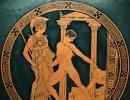Презентация - История возникновения Стоунхенджа - Stonehenge (на английском языке). Презентация - История возникновения Стоунхенджа - Stonehenge (на английском языке) Скачать презентацию на тему стоунхендж английском
Слайд 1
Stonehenge
Stonehenge, one of the great Seven Wonders of the World
Слайд 2

Great Britain
Слайд 3

Back when Stonehenge was built people had no way of telling the time. Perhaps the Druids wished to keep records of events. Stonehenge is said by some to be one widespread sundial, a clock used in ancient times. When the sun rises it casts a shadow though an opening in the one side of Stonehenge, the day passes and the shadow move across the middle showing the druids the time of day.
Слайд 4

It situated about 3 km west of Amesbury and 13 km north of Salisbury
The Stonehendge is in a county Wiltshire, in vicinities of Salisbury. The nearest motorways – А303 and А344/360. The nearest railway stations – Salisbury and Grejtli (approximately in 16 kilometres). From London it is necessary to go from station Waterloo by train to Salisbury (1,5 hours). Further at station in Salisbury it is possible to buy the ticket for the bus in a Stonehendge.
Слайд 5

Gathering place for religions
Gathering place for religions
So taking in to account that Stonehenge could predict eclipses another thought is that it was just used for predicting the full moon. The full moon meant new life, so perhaps they used Stonehenge for ceremonies to worship new life.
Слайд 6

Nobody knows its precise purpose.
Слайд 7

They say that it is connected with the sun and the moon.
The moon, it has been a sight for all over time. Back long ago little was none of the reasons for an eclipses, it was thought to be a sing from the gods. In a society which worshiped gods for all the mysteries of the world, the eclipse must have been very special. The builders of Stonehenge must have been marveled at the sight of this holy event, which happened every four years. Most likely the great Stonehenge was built to be a prediction device for the eclipse. Many people have studied Stonehenge and many have found that the stones are mathematically placed to show when and eclipse might occur. "In favor of this solution - that the Aubrey holes were used as a computer are these facts: the number 56 is the smallest number that measures the swing of the moon with an over-all accuracy of better than 3 days, and lunar cycles provide the only method of long-range eclipse prediction related to the seasons of the year."
Stonehenge is a prehistoric monument located in the English county of Wiltshire . One of the most famous sites in the world, Stonehenge is composed of earthworks surrounding a circular setting of large standing stones . It is at the centre of the most dense complex of Neolithic and Bronze Age monuments in England, including several hundred burial mounds .
Stonehenge I The native Neolithic people of England began construction of Stonehenge I by digging a circular ditch using deer antlers as picks. The circle is 320 feet in diameter, and the ditch itself was 20 feet wide and 7 feet deep. they used the chalky rubble taken from the ditch to built a steep bank circle just inside the outer circle. Inside the bank circle, they dug 56 shallow holes known as the Aubrey holes. two parallel stones were erected at the entrance to the circle, one of which, the Slaughter Stone, still survives. Also surviving are two Station Stones, positioned across from each other on opposite sides of the circle, which may also have been erected during this time. Stonehenge I seems to have been used for about 500 years and then abandoned.
Stonehenge II Construction of Stonehenge II began around 2100 BC. A semicircle of granite stones known as bluestones was assembled within the original bank and ditch circles. The bluestones come from the Preseli Mountains in South Wales, nearly 250 miles away. There were about 80 of them, weighing up to 4 tons each. How they were transported is not known, although scholars don"t regard the feat as impossible and various theories have been presented. Second, the entranceway to the semicircle of bluestones is aligned with the midsummer sunrise. The alignment was continued by the clearing of a new approach to the site, "The Avenue," which has ditches and banks on either side like the original outer circle .
Stonehenge III Stonehenge III is the stone circle that is still visible today. During this phase, which was started in about 2000 BC , the builders constructed a circle of upright sarsen stones, each pair of which was topped with a stone lintel (horizontal capstone). The lintels are curved to create a complete circle on top. There were originally 30 upright stones; 17 of these still stand. Within this stone ring was erected a horseshoe formation of the same construction, using 10 upright stones. Here the trilithons stand separated from one another, in 5 pairs. Eight of the original ten stones remain. The horseshoe shape opens directly towards the Slaughter Stone and down the Avenue, aligned with the summer solstice sunrise.
John Aubrey was one of the first to examine the site with a scientific eye in 1666, and recorded in his plan of the monument the pits that now bear his name . William Stukeley continued Aubrey’s work in the early 18th century, but took an interest in the surrounding monuments as well, identifying the Cursus and the Avenue. The most accurate early plan of Stonehenge was that made by Bath architect John Wood in 1740.His original annotated survey has recently been computer redrawn and published. Importantly Wood’s plan was made before the collapse of the southwest trilithon, which fell in 1797 and was restored in 1958. Archaeological research and restoration .
William Cunnington was the next to tackle the area in the early 19th century. He excavated some 24 barrows before digging in and around the stones and discovered charred wood, animal bones, pottery and urns. William Gowland the first major restoration of the monument in 1901 which involved the straightening and concrete setting of sarsen stone number 56 which was in danger of falling. In straightening the stone he moved it about half a metre from its original position. Gowland also took the opportunity to further excavate the monument in what was the most scientific dig to date.
Richard Atkinson , Stuart Piggott and John F. S. Stone re-excavated much of Hawley"s work in the 40s and 50s, and discovered the carved axes and daggers on the Sarsen Stones. in 1978 by Atkinson he discovered the remains of the Stonehenge Archer in the outer ditch. More recent excavations include a series of digs held between 2003 and 2008. This project mainly investigated other monuments in the landscape and their relationship with the stones - notably Durrington Walls. A new landscape investigation was conducted in April 2009. A shallow mound, rising to about 40 cm (16 inches) was identified between stones 54 (inner circle) and 10 (outer circle), clearly separated from the natural slope . In July 2010 the Stonehenge New Landscapes Project discovered what appears to be a new henge less than 1 kilometre away from the main site.
Стоунхендж (англ. Stonehenge, букв. «каменный хендж») мегалитическое сооружение в графстве Уилтшир, Англия, представляющее собой комплекс кольцевых и подковообразных земляных и каменных конструкций. Это один из самых знаменитых археологических памятников в мире.


Стоунхенджа был возведен на рубеже каменного и бронзового веков. Причем создание этого удивительного магического места происходило в несколько этап. Первый приходится примерно на 3100 года до нашей эры. Именно тогда были созданы ров и внутренний земляной вал в виде окружности, диаметром 115 м, шириной 2,5 м и высотой 5080 см. Спустя почти тысячу лет началось «строительство» того, что станет главной основой Стоунхенджа. На равнину Солсбери были доставлены 80 больших камней. Их установили внутри рва двумя концентрическими кругами с внешней и внутренней стороны полу эллипса триплетов. Спустя еще несколько столетий было возведено кольцо из тридцати огромных песчаниковых монолитов 31 м в диаметре. Правда, в настоящее время из них осталось стоять только 17. Примерно в 1800 году до нашей эры Стоунхендж вновь был «реконструирован» и уже приобрел привычный нам вид.

На плане выделяются: 1 Алтарный камень, шести тонный монолит зеленого слюдяного песчаника из Уэльса 2-3 Курганы без могил 4 Упавший камень 4,9 метров в длину (Slaughter Stone эшафот) 5 Пяточный камень (Heel Stone) 6 Два из первоначально четырех вертикально стоящих камней 7 Ров (канава) 8 Внутренний вал 9 Внешний вал 10 Авеню, то есть параллельная пара рвов и валов, ведущая за 3 км на реку Эйвон; сейчас эти валы едва различимы 11, 12 Кольца 30 ям 13 Круг 56 ям, известный как лунки Обри (Aubrey holes) 14 Малый южный вход

Сложно установить истинное предназначение Стоунхенджа поскольку на древних камнях нет никаких надписей, пометок, вообще ничего. Одна из самых распространенных научных теорий о предназначении Стоунхенджа говорит о том, что он, скорее всего, был древней астрономической обсерваторией, благодаря которой жрецы могли высчитывать лунные и солнечные дни, отмечать даты проведения важных праздников и так далее.

Профессор Дж. Митчел, проведя компьютерный анализ Стоунхенджа и попытавшись с помощью современных цифровых технологий восстановить первоначальный вид Стоунхенджа, сделал заключение, что он представляет из себя, ни больше ни меньше, точную модель солнечной системы в поперечном разрезе. При этом, древние астрономы исходили из того, что в Солнечной системе не девять, а двенадцати планет, две из которых находятся за орбитой Плутона. А третья планета, еще больше поставила ученого в загадки, ведь она предполагалась между орбитой Марса и Юпитера, а на этом месте как раз находиться пояс астероидов.

Также часто утверждают, что Стоунхендж использовался для захоронений. После проведённых раскопок учёные пришли к выводу, что всего в Стоунхендже было захоронено около 240 человек, которые перед погребением были кремированы. При этом археологи считают, что вероятнее всего здесь хоронили представителей местной элиты или правящей династии.

Английский писатель и историк Том Брукс в результате своих многолетних исследований сделал вывод, что Стоунхендж входил в состав гигантской навигационной системы, состоящей из равнобедренных треугольников, вершина каждого из которых указывала на следующий пункт


Еще в 20-х годах минувшего века известный геолог X. Томас установил. что камни для возведения комплекса доставлялись из каменоломен. которые находились более чем за 300 километров от места строительства! Не нужно говорить, что транспортировка гигантских каменных блоков требовала невероятных усилий.

Благодарю за просмотр. Сайты, послужившие источниками материала для презентации:

Characteristics It is located in
Wiltshire, England.
It is a monument built
in the Neolithic and
Bronze Age.
Stonehenge is a large
circle of
standing stones.
How was it built?
FIRST STAGE
The first Stonehenge was a largeearthwork probably built around 3100 BC.
They formed a circle. Archaeologists found
cremated human bones, but they were
probably from part of a religious
ceremony.
After that, the monument didn’t change
until 1000 years later.
SECOND STAGE
It started around 2150 BC. About 82bluestones from the Preseli mountains in
south-west Wales were brought to the site.
This journey was nearly 240 miles.
Once there, the stones were set up in the
centre to make an incomplete double
circle.
THIRD STAGE
It started in 2000 BC. The Sarsen stonesthat they used were probably brought from
the Marlborough Downs area near
Avebury, about 25 miles north of
Stonehenge.
These were placed in an outer circle.
Inside the circle, there were also five
trilithons, that still remain today.
FINAL STAGE
After 1500 BC the bluestones were movedinto the horseshoe and circle that we see
today.
Most of the bluestones have been
removed or broken.
Possible theories about Stonehenge
Stonehenge was an astronomicalobservatory
They could predict eclipses, lunar phases and
seasons. Nevertheless, it was possible that it
was not the original function because it took
more than 1000 years to finish it.
Stonehenge was a cemetery
Scientists found human bones buried there.
Diapositiva 9
Stonehenge was a religious templePeople went there because the Druids
could give them magic power and cure
their illnesses.
Incredible theories
Stonehenge wasbuilt by Apollo’s
followers who
lived in the north
of Europe and
were
documented in
Greek mythology.
Stonehenge
was a place
where UFOs
landed.
Diapositiva 11
Stonehenge wascreated in the first
years of the XX
century to attract
tourists.
Stonehenge was
built by the wizard
Merlin. He made it
himself by raising
the stones with his
magical power.
Vocabulary:
Bluestone -piedras del Stonehengetraídas de fuera
Bronze age -edad de bronce
(to) cremate -incinerar, cremar
Druid -Druida
Horseshoe -herradura
Neolithic -neolítico
Sarsen stone -piedra arenisca
Standing stone -megalito vertical
Trilithon -estructura de dos piedras
verticales (columnas) y una horizontal
apoyada en la verticales.
UFO -OVNI (objeto volador no identificado)
Wizard Merlin -El mago Merlín
1 слайд

2 слайд
Location of Stonehenge Stonehenge is a prehistoric monument located in the English county of Wiltshire about 3.2 kilometres west of Amesbury and 13 kilometres north of Salisbury.

3 слайд
Plan of Stonehenge 1 = The Altar Stone, a six ton monolith of green micaceous sandstone from Wales 2 = barrow without a burial 3 = "barrows" (without burials) 4 = the fallen Slaughter Stone, 4.9 metres long 5 = the Heel Stone 6 = two of originally four Station Stones 7 = ditch 8 = inner bank 9 = outer bank 10 = The Avenue, a parallel pair of ditches and banks leading 3 km to the River Avon 11 = ring of 30 pits called the Y Holes 12 = ring of 29 pits called the Z Holes 13 = circle of 56 pits, known as the Aubrey holes 14 = smaller southern entrance

4 слайд

5 слайд
Astronomy and Stonehenge The prehistoric monument of Stonehenge has long been studied for its possible connections with ancient astronomy. Archaeoastronomers have claimed that Stonehenge represents an "ancient observatory," although the extent of its use for that purpose is in dispute. Many also believe that the site may have had astrological/spiritual significance attached to it as well. The discovery of evidence for a neighbour to the Heel Stone has challenged the interpretation of it as a midsummer sunrise marker. The second stone may have instead been one side of a "solar corridor" used to frame the sunrise.

6 слайд
Druids Temple The theory that the Druids were responsible may be the most popular one; however, the Celtic society that spawned the Druid priesthood came into being only after the year 300 BC. Additionally, the Druids are unlikely to have used the site for sacrifices, since they performed the majority of their rituals in the woods or mountains, areas better suited for "earth rituals" than an open field.
7 слайд
Stonehenge as a graveyard There is a theory that Stonehenge was used for burials. Indeed, burials were found on the monuments territory, but they were made much later after Stonehenge had been built. According to news reports, a professor of archeology from the University of Sheffield, Mike Parker Pearson, who manages the Stonehenge Riverside Archaeological Project noted that in his opinion Stonehenge from the very beginning of its existence and to flourish in the third millennium BC was considered by inhabitants of England as an area for the burial of the dead.

8 слайд
Legends Many early historians were influenced by supernatural folktales in their explanations. Some legends held that Merlin had a giant build the structure for him or that he had magically transported it from Mount Killarausin Ireland, while others held the Devil responsible. Henry of Huntingdon was the first to write of the monument around 1130 soon followed by Geoffrey of Monmouth who was the first to record fanciful associations with Merlin which led the monument to be incorporated into the wider cycle of European medieval romance. According to Geoffrey"s Historia Regum Britanniae, using his magic Merlin took the circle from its original place in Ireland at the behest of Aurelius Ambrosius to serve as an appropriate burial place for Britain"s dead princes.

9 слайд
Conclusion It’s difficult to judge which of the theories is correct, but from what I have read I can do the conclusion that Stonehenge is the most mysterious symbol of Britain, which went through the whole history with this country and gives it special charm of mystery and unexploredness .






